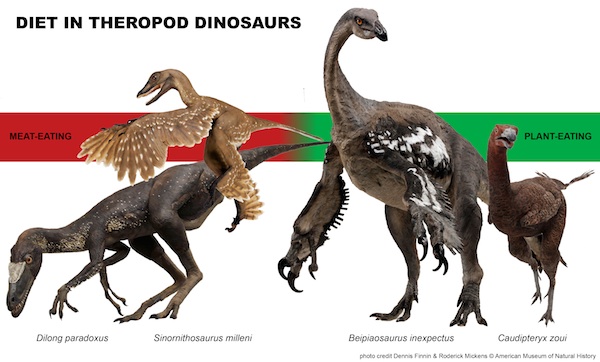Closet Veggie-Lovers?: 'Predatory' Dinos Ate Plants

Dinosaurs long thought to be predatory have been outed as plant-eaters by their anatomical features — including birdlike beaks.
A new analysis of Coelurosauria, the group of theropod dinosaurs that includes bruisers such as T. rex, finds that dedicated hunters were likely the exception, rather than the rule. The findings, published the week of Dec. 20 in the journal Proceedings of the National Academy of Sciences, suggest that famous Coelurosaur predators likely had some veggie-lovers in the family tree.
"Anything that belongs in that group that seems to be an exclusive meat-eater — things like Velociraptor of 'Jurassic Park' fame — it means it probably evolved from an ancestor that had already begun eating some plants," study author Lindsay Zanno of the Field Museum in Chicago told LiveScience.
The anatomy of a plant-eater
Coelurosaurs are the subset of dinosaurs most closely related to birds. They've long been considered hunters, Zanno said, but recent fossil discoveries revealed Coelurosaurs with peg-like teeth or beak-like mouths. While the knife-like chompers of a T. rex or Velociraptor were obviously for tearing meat, these new finds are ambiguous. After all, birds today eat almost everything with their beaks, from berries to carrion.
Zanno and her Field Museum colleague Peter Makovicky started by collecting what little firm dino-diet data they could find. They identified 72 Coelurosaur species that had been found with direct fossilized evidence of what they ate, including fossilized stomach contents and feces. Then the researchers statistically analyzed those dinosaurs' anatomy, looking for physical traits that correlated with plant-eating.
They found 21 markers of a plant-eater, including a longer neck, leaf-shaped or peg-like teeth, and the evolution of a beak. When the researchers applied the findings to the rest of the Coelurosaur family, they found 44 species across six subgroups that likely ate at least some plant matter, judging by their anatomy.
Sign up for the Live Science daily newsletter now
Get the world’s most fascinating discoveries delivered straight to your inbox.
"It appears as if the transition from carnivory, or meat-eating, to plant-eating occurred very early in the evolutionary history of the group and probably occurred once," Zanno said. That means that dinosaurs like T. rex and Velociraptor likely evolved back to meat-only diets after their ancestors spent at least some time chowing on plants.
Herbivore origins
"We're not seeing special cases of herbivory evolving from carnivorous ancestors," said Thomas Holtz, a vertebrate paleontologist at the University of Maryland who was not involved in the study. "We're seeing one origin of herbivory here."
The find raises new questions about the ecological niches Coelosaurs inhabited, Holtz said, such as whether switching to plant-based diets restricted their range.
The study is also important for understanding the evolutionary history of birds, Zanno said. Although beaks evolved independently many times throughout history, the new study suggests that a plant-based diet was the push Coelosaurs needed to turn toothy mouths into beaks.
"Once you have a beak, you can adapt it into all different shapes and sizes, and you can adapt it to do all different kinds of things," Zanno said.
- 25 Amazing Ancient Beasts
- Gallery of Fantastic Fossils
- Turkey Runs Like Winged Dinosaurs
You can follow LiveScience Senior Writer Stephanie Pappas on Twitter @sipappas

Stephanie Pappas is a contributing writer for Live Science, covering topics ranging from geoscience to archaeology to the human brain and behavior. She was previously a senior writer for Live Science but is now a freelancer based in Denver, Colorado, and regularly contributes to Scientific American and The Monitor, the monthly magazine of the American Psychological Association. Stephanie received a bachelor's degree in psychology from the University of South Carolina and a graduate certificate in science communication from the University of California, Santa Cruz.









